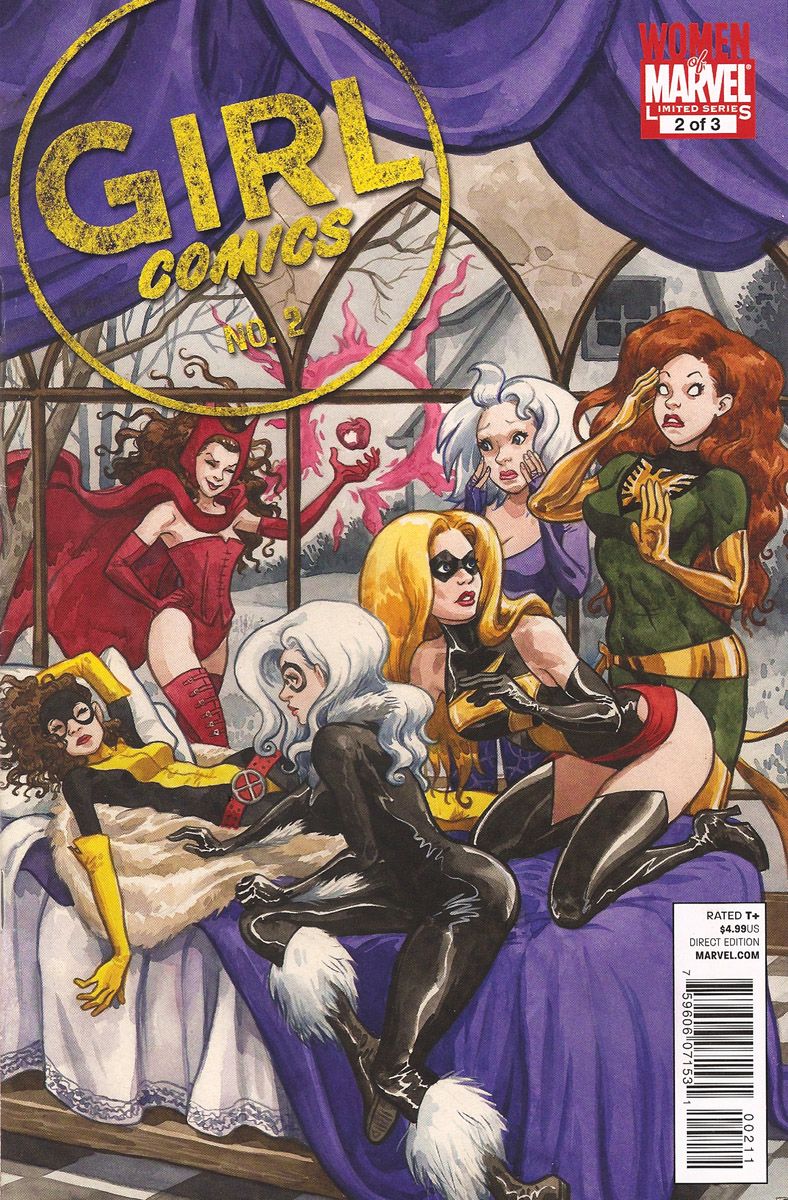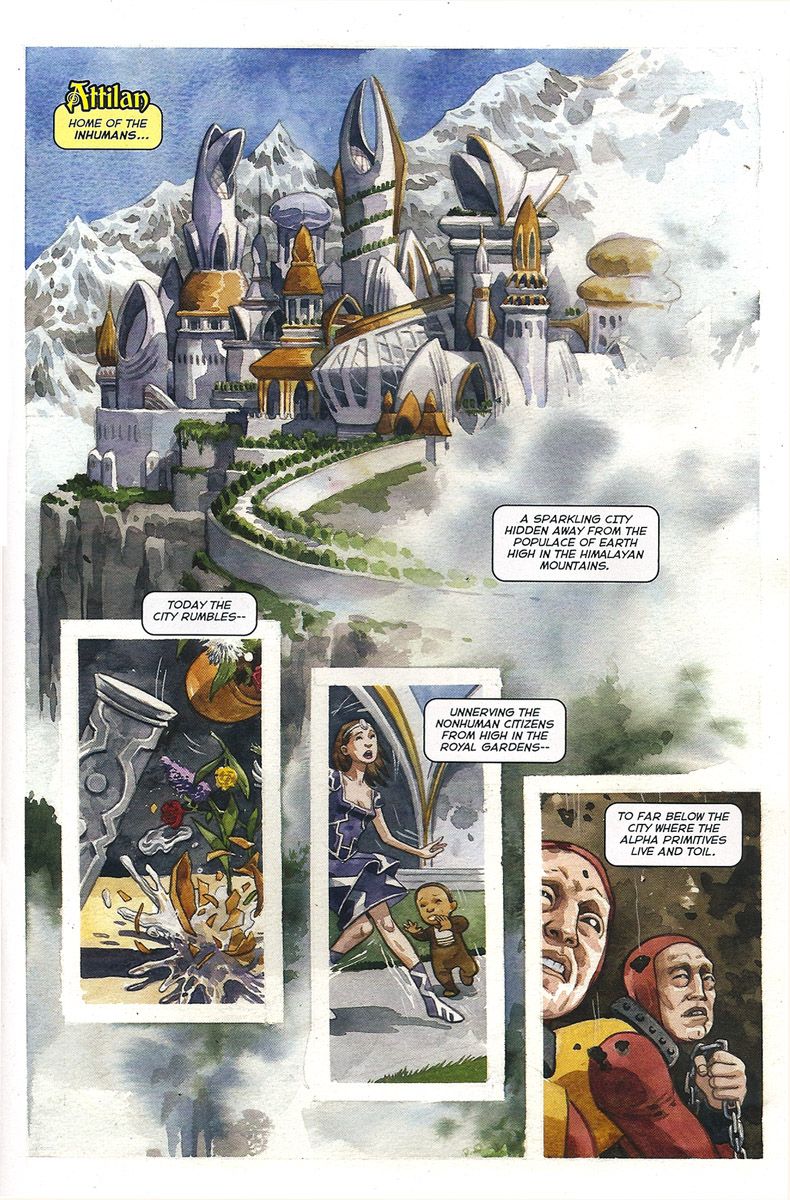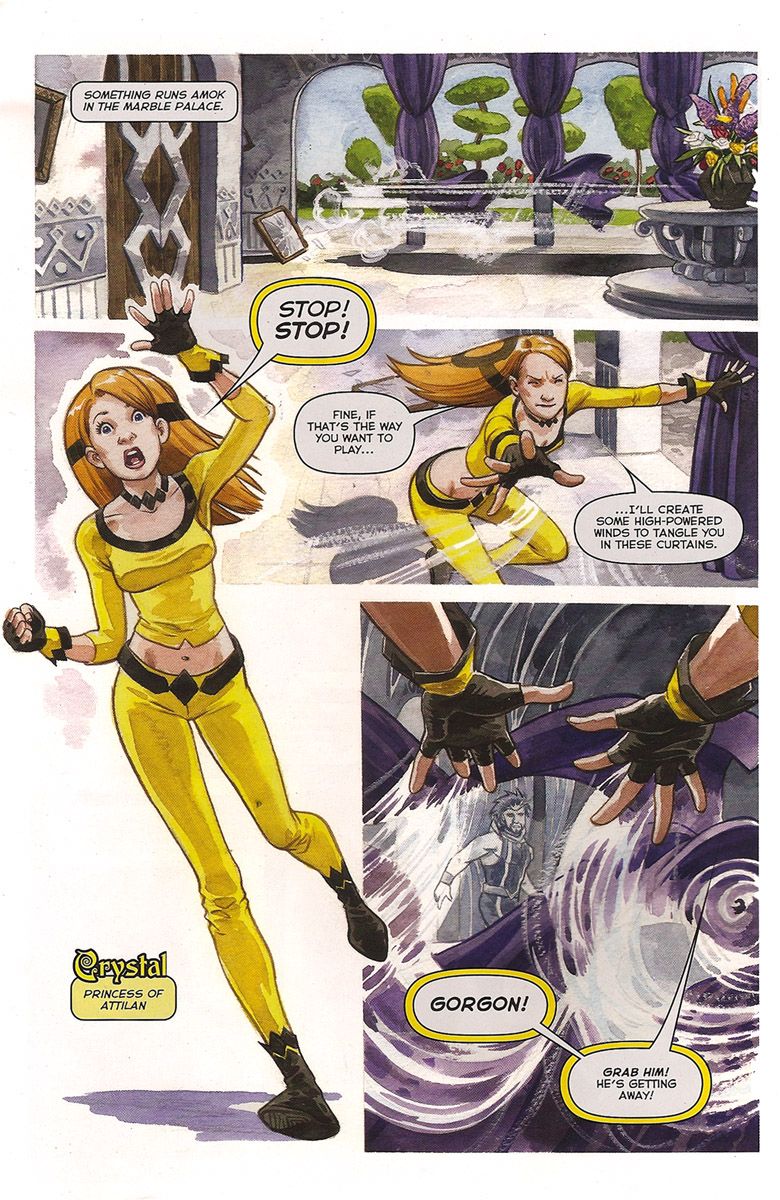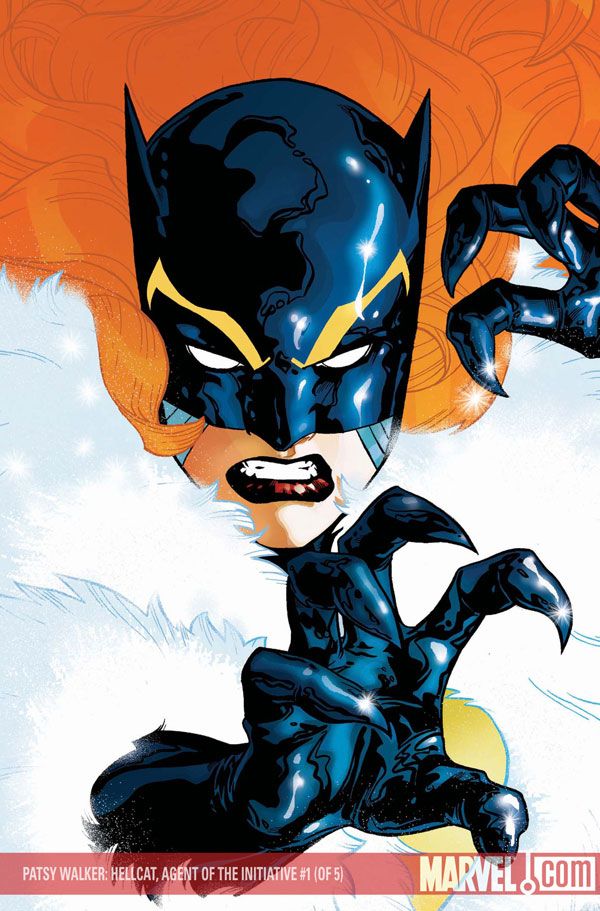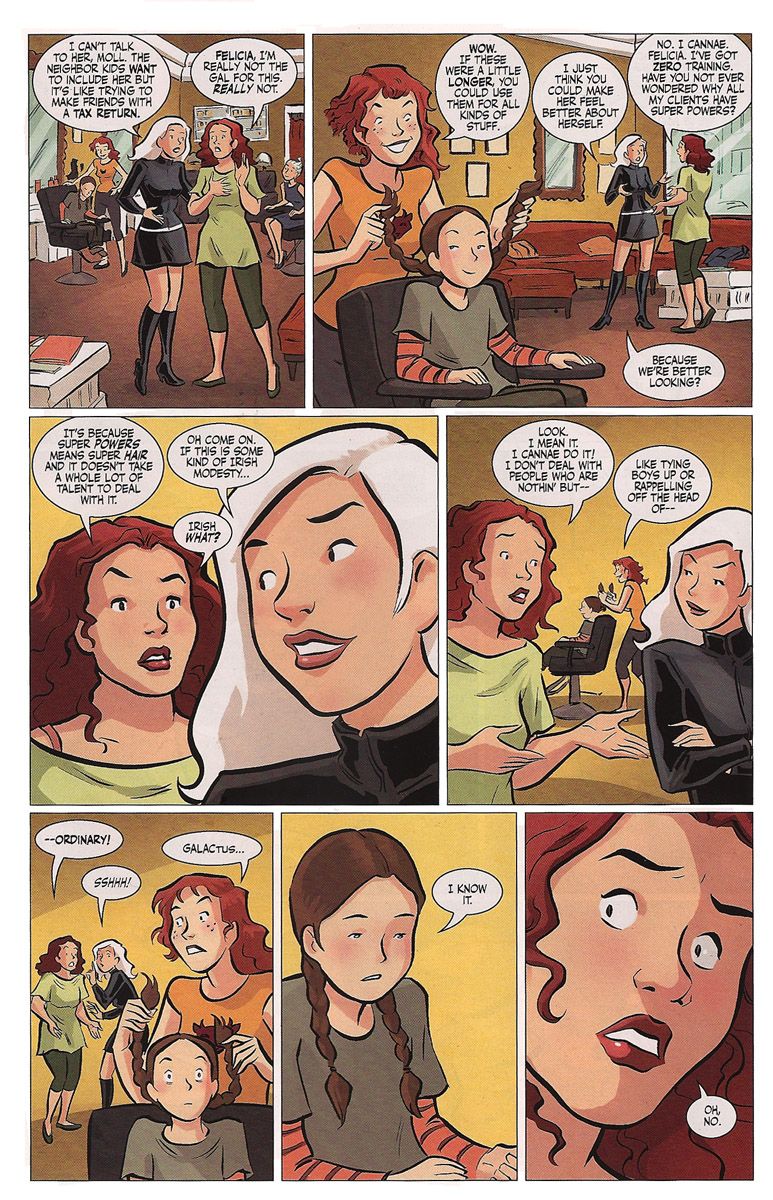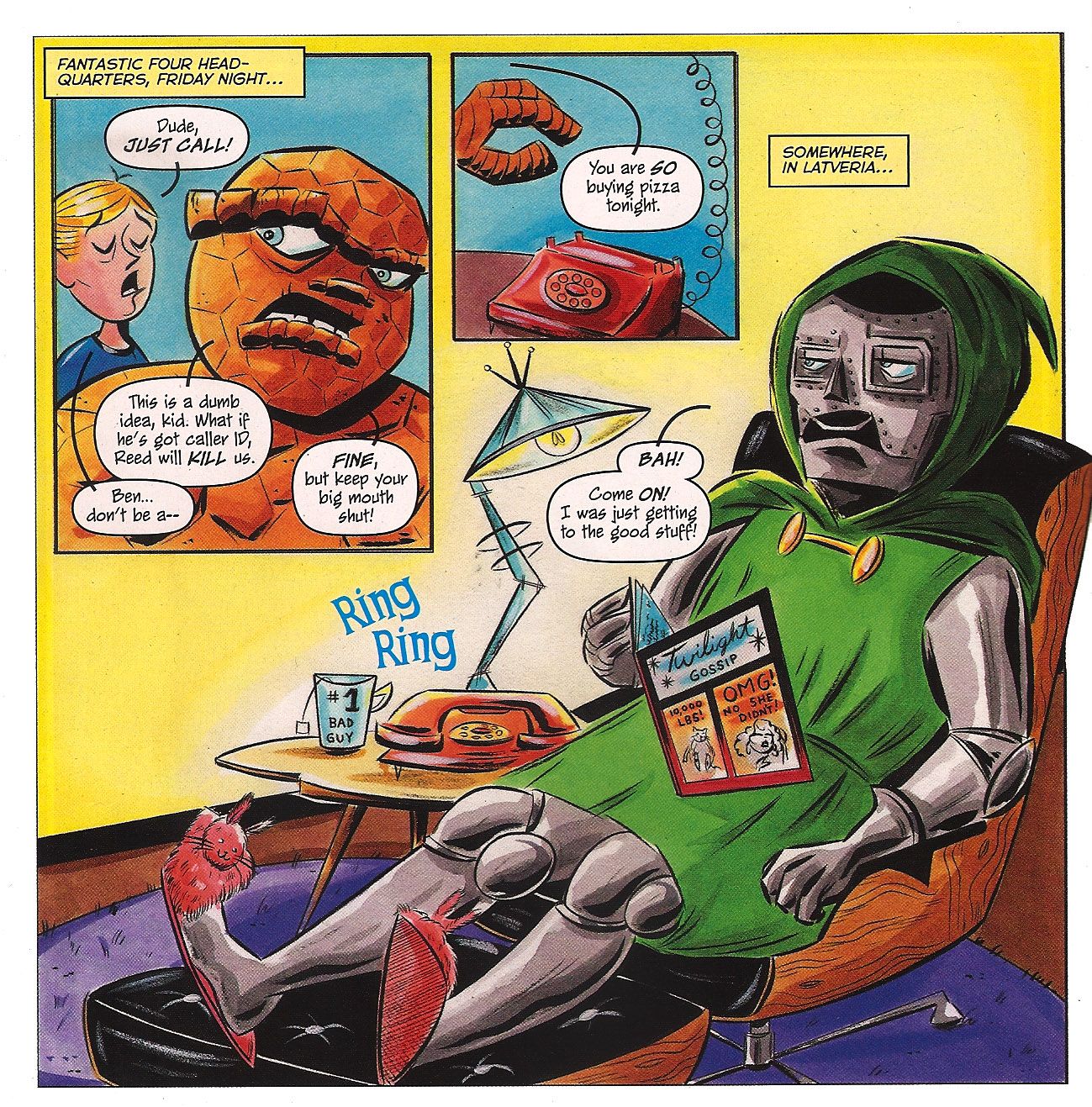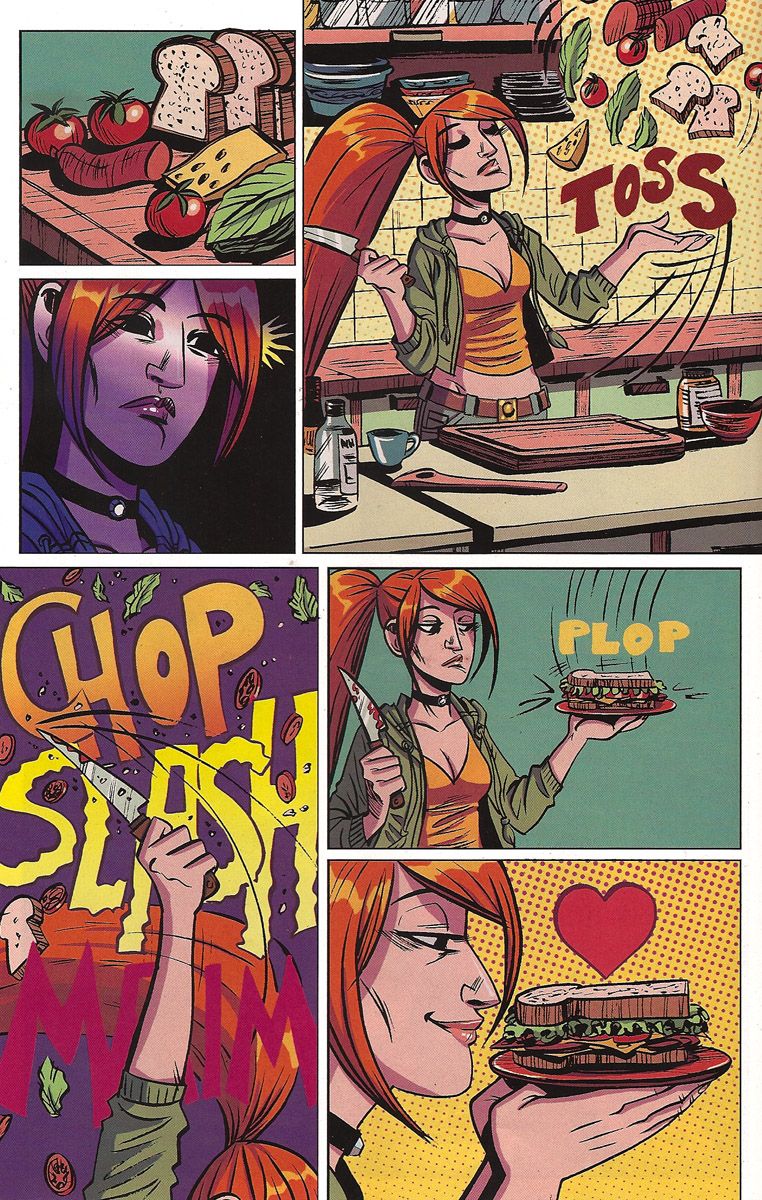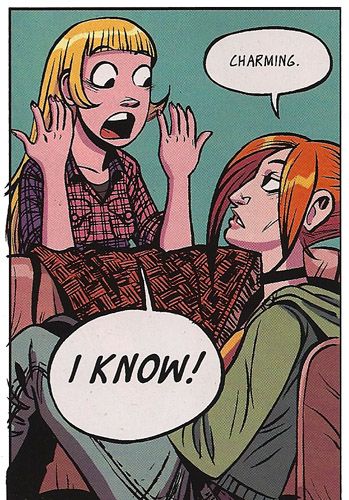Girl Comics #2 (of 3). Jill Thompson (writer/artist), Colleen Coover (writer/artist), Stephanie Buscema
(writer/artist), Faith Erin Hicks (writer/artist). Kathryn Immonen (writer), Abby Denson (writer), Christine Boylan (writer). Emma Vieceli (artist), Cynthia Martin (artist). Elizabeth Breitweiser (colorist), Cris Peter (colorist), Emily Warren (colorist), June Chung (colorist). Colleen Doran (pin-up artist), Ramona Fradon, Rebecca Buchman, and June Chung (pin-up artists). Marvel. 48 pages. $4.99.
So Greg Burgas and I are in almost total agreement on the second issue of Girl Comics – the gist being that it’s still a mixed bag – like any anthology is – but that overall it’s stronger than the first issue. As a bonus for me (and maybe also Greg?) there were certainly no overt objectifying land mine issues for me to step on like issue one’s ill-conceived She-Hulk pin-up.
Part two of Colleen Coover’s introduction is as beautifully illustrated as the first and seeing it here I think that it’s probably a really nice way to link and anchor the three issues together with some consistency considering the variety of creators, characters, and types and lengths of stories, etc.
The second piece, a sweet, lighthearted, and exceptionally illustrated six-page story “Dogged Pursuit” by Jill Thompson is excellent. I think Thompson’s piece is the perfect example of a successful short story for an anthology such as this because Thompson doesn’t try to do too much. Instead she takes basically a one line joke or premise – in this case “Lockjaw the giant teleporting dog doesn’t want to take a bath” and then peppers it with superheroes that fit the story and uses them in creative and fun ways to service the joke or premise.
Thompson’s piece is successful in the same way that Lucy Knisley’s Doc Ock story from GC #1 was successful – the idea was simply “Doc Ock goes shopping”. Short stories, whether in prose or image – moving or still - is a tricky balance. While it’s wonderful to see artists like Thompson and Knisley nailing it here, I kind of hate taking others to task for not quite succeeding when it’s obvious how complicated and nuanced it really is.
Which leads us to the third piece in the collection, “Good To Be Lucky” written by Kathryn Immonen and exceptionally illustrated by Colleen Coover. The eight-page story tries a little too hard I think and tries to do way too much and in the process loses whatever it was Immonen was trying to say. But here I think is the time to come clean about my fraught relationship with Immonen’s work. I think Immonen has a powerful voice that’s full of character – and I suspect that it’s a voice that works well for teens (and tweens) as it feels to me quite young and topical and fresh, but despite the power of her voice I almost always find myself lost from a storytelling point of view. Immonen’s Hellcat series – which in issue #1 I was absolutely in love with – had confused me so much by the end of issue #2 that I never quite figured out what the hell was going on for the rest of the mini-series. I had a similar problem with Immonen and Pichelli’s recent Pixie mini-series, except that in that case I had no idea what was going on from page one. Her work with Pichelli on Runaways seemed a little more contained and clear - maybe the problem is less about Immonen’s writing than about magic as a driving plot device - which both Hellcat and Pixie featured heavily, but Runaways less so? It's possible I suppose. But this short story suggests it's unlikely, as I find myself a bit lost yet again with no magic present. It's strange to me to be so into a writer's voice and style and yet have to admit a basic lack of understanding when it comes to the actual stories...I don't recall ever feeling so split about a writer before.
Anyway, “Good To Be Lucky” is helped immensely by Coover’s very clear storytelling style but the story still tries to do way too much in too few pages and as a result all message or purpose seems lost. The story merges Shamrock (who I worry may be a little too obscure to ask so much pre-knowledge of from the reader), The Invisible Woman, Hellcat, Black Cat, and Black Cat’s niece, Lou – five quite distinct and relatively disconnected characters through Shamrock’s hair salon which is apparently for "supes only". I never quite understood the concept of Shamrock’s supes only salon – I’m not sure how superpower equals super hair (unless you’re Medusa) and the eventual solution to the problem of not being able to work on non-powered Lou's hair – by styling it with super villain glue seems equally as “off” as everything else. It’s nice of course that "ordinary" Lou saves the day instead of all the heroines surrounding her, but it’s a bummer that she does so by punching the villain, not unlike any of the superheroines might have. I have no problems with violence as a solution...especially in comics...hell that's what we're here for half the time...but it just seemed kind of lazy...like the easy way out. But maybe I’m missing the point…like I said, there is A LOT going on in these eight pages.
What I will say is that there were several cute and funny moments that worked thanks to both Immonen’s witty dialogue and Coover’s adorable and expressive cartooning. For example the page below - the panels with Hellcat playing with Lou's hair – very cute and sold largely thanks to Coover’s excellent facial expression work.
Like Greg, I found Stephanie Buscema’s two page "Doom Hearts Sue!" story to be refreshing and thoroughly enjoyable. The premise is simply “Johnny and Ben call Dr. Doom and pretend to be his friend Galactus”…the results are great. Also like Greg, I too love some “behind the scenes/day in the life of a superhero (or villain)” stories – and like the Knisley Doc Ock piece from issue #1, Buscema takes a villain and shows a softer (and much more hilarious) side. In addition to the solid idea and sharp writing, Buscema’s cartooning is rather brilliant – bringing more personality to Johnny Storm, Ben Grimm, and Dr. Doom in two pages than I’ve seen in years – if ever.
Elsa Bloodstone and I apparently share a mutual and devoted love of sandwiches in “Do You Ever?” a Faith Erin Hick’s piece that has Tabitha (Boom Boom) and Elsa talking about if either had ever considered using their powers for evil, rather than good.
My only exposure to Hick’s work is her book Zombies Calling, which while fun and I can certainly see the appeal, I never really fell for, in part because the art wasn’t something I responded to. However here, in full and vibrant color I find her art totally captivating and well-matched for the story she chose to tell. The cartoony exaggerated style brings real life to the characters (much like Buscema’s does) and I found myself happily enchanted with the story. Greg is right that Boom Boom (is it Boomer now? I always preferred Boom Boom) comes off as a bit ditsy and dim, but I enjoyed it anyway – especially since it gave me a chance to enjoy awesome panels like this:
The sixth piece, a two-page story called “Ad Vice” by Abby Densen (writer) and Emma Vieceli (art) falls completely flat. It’s essentially Mary Jane imagining the "looking for love classified ads" of male superheroes…and while that concept is nice and simple and should work in theory, it’s unfortunately really condescending to female readers in my opinion, not only asking very little of them as readers, but encouraging them to objectify men in the same ways that I think most of us are well-tired of being objectified. If the shoe was on the other foot and this story was done by a man, about a male character imagining female character's classified ads instead, I would find it pretty offensive and sexist…so I think I have to say that I do find it sexist? I want stories that are respectful of both genders…not stories that drag male characters into the same horrible situations that I keep angrily finding my female characters in. Beyond that though, the story just stoops to the laziest of clichés, doesn't manage to be funny, and says nothing insightful or new about the characters in question. The art is not the biggest problem of the piece, but it’s overly dark and certainly nothing that can save the story. Huge miss here, fortunately it’s only two pages.
The last piece, called “Bondeau” by Christine Boylan (writer) and Cynthia Martin (art) is a real downer of a piece overall and a terrible choice to end an otherwise fairly strong collection with. It's a strange choice - I was always told (in art school) that you start strong and end strong - burying your weaker pieces in the middle and making sure that you end on a high note. This is not that high note they should be ending GC2 with. It’s by far the most dark and humorless of the stories (and when I say dark, I mean both figuratively and literally) and tonally it’s completely out of synch with the rest of the book, which mostly trends light and fun. The story, a tale about Adria (aka Adria The Witch) finding Dr. Strange (who has apparently been in hiding) and trying to steal his power from him. Or at least I think that’s what’s happening. The storytelling is very unclear and the wordy dialogue is mostly used as distraction so that Strange can escape or trick her…or something…things that I’m supposed to be able to understand through the artwork, but can’t. There’s really nothing I dislike more in comics than badly paced hard to understand visuals…I mean, otherwise I might as well just be reading prose, right? Additionally, while it’s really only obvious in one panel, Adria’s outfit, a dress with a neckline cut down to her stomach seems like an exceptionally poor (and unnecessary) costume choice.
There are two nice pin-ups in this issue – a powerfully built and serious Valkyrie by Colleen Doran, and a Miss America by Ramona Fradon, Rebecca Buchman, and June Chung - and they are both are big steps forward from the revealing She-Hulk of last issue.
The three Marvel Women Spotlight pieces – featuring June Tarpe Mills, Ruth Atkinson, and Valerie Barclay were also better this time around – and the piece on Mills was particularly interesting. However, I did not appreciate Marvel’s attempt to wedge in a last ditch attempt at justifying the ridiculous “Girl Comics” title in Atkinson’s spotlight piece. Marvel: We’re all well aware that there was a book in the 50’s called Girl Comics – we just continue to question the decision to use a title in 2010, that you used nearly 60 years ago. Times…they are a changing Marvel...in case you hadn’t noticed, and what may have been relevant and appropriate (maybe!?) in 1950, does not make it so in 2010.
That said, I’m enjoying Girl Comics despite the title, and I hope you’ll (that’s you Marvel) keep many of these talented ladies on for interesting and forward thinking future projects once this one is over. The only way that Girl Comics can really fail at this point, as far as I’m concerned, is if you send all these ladies packing when this special project ends. So far, at a minimum, I’d say Lucy Knisley, Jill Thompson, Colleen Coover, Faith Erin Hicks, Stephanie Buscema, Emma Rios (who it looks like is doing a Strange series with Mark Waid?), Devin Grayson, and Agnes Garbowska are all writers and artists that I haven’t seen lately with any high profile regularity in the Marvel (or DC) universes, that I would pay good money to read stories from. Whaddya say Marvel?
Totally unrelated to Girl Comics - but related to She Has No Head! business - if any of you stopped by to read the Ross Campbell Shadoweyes advance review and exclusive preview post last week and wanted to comment but found you couldn't, I apologize, we had a small technical error (by which I actually mean "user error")...but the comments are now open if you have anything you'd like to say on that post. As always - thanks for reading!


